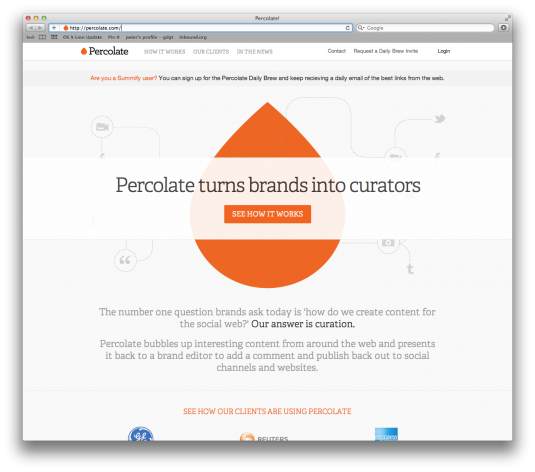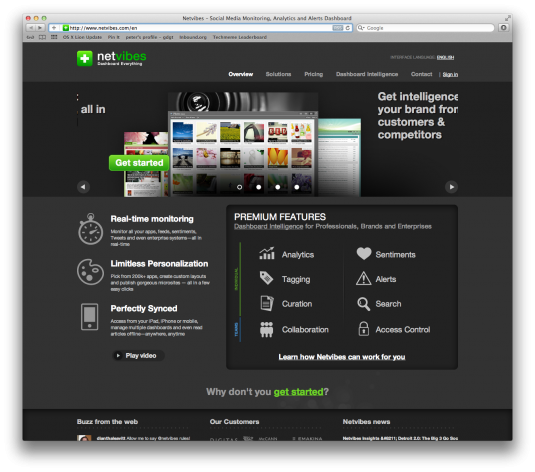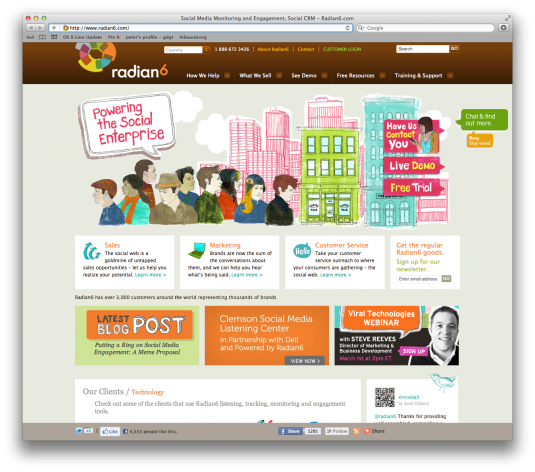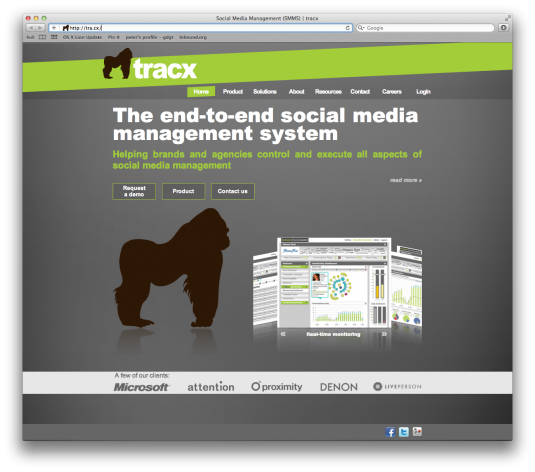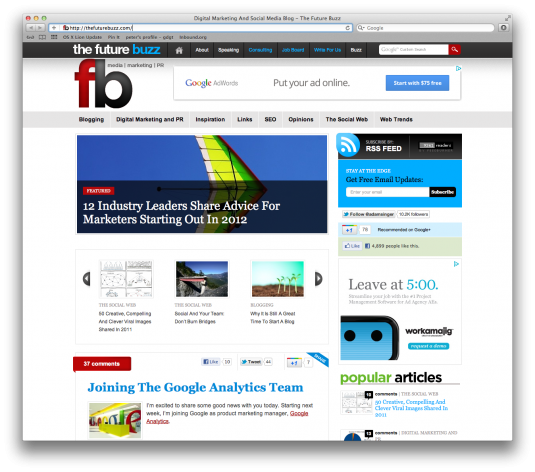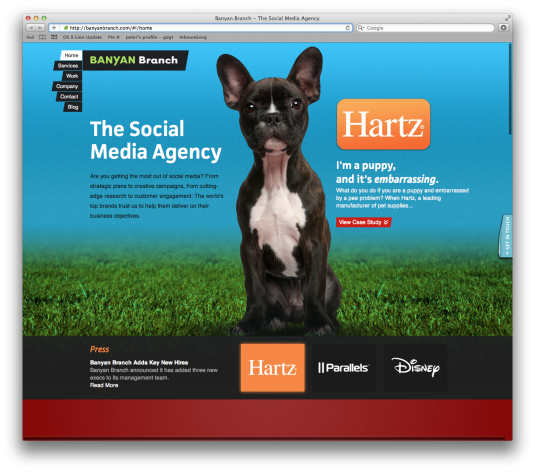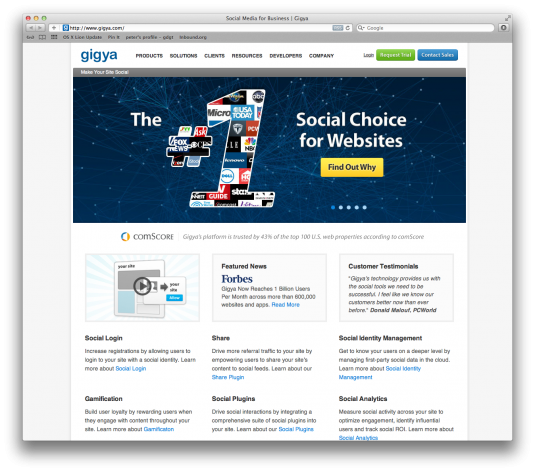Erik Qualman's Blog, page 660
May 25, 2012
Getting Social With User-Generated Video

[image error]User-generated video is becoming a hot commodity online as its value and advantages become more obvious. Marketing departments in particular understand how user-generated video can benefit their allocation of finances, time and resources while improving their efficacy in promoting a product, service or brand.
User-generated video is now more accessible through video capturing services that are available to any business or organization, no matter how small. Here are just a few benefits you can experience by investing in user-generated video:
Video Production at a Greatly Reduced Cost
Producing a commercial or high-quality video complete with a set, script and all the required equipment can cost thousands of dollars. Although user-generated video often lacks the production value, it’s plentiful and at a nominal cost. Since users create the video from their own devices in their home or office, there’s very little overhead for you and your business.
Unscripted Video is More Genuine, More Authentic
Consumers can tell when they’re being fed a well-scripted line. By contrast, they can also tell when a person is speaking on their own accord. By having your customers produce video testimonials or feedback, you let them put their feelings and thoughts into their own words. The result? A much more organic video clip that can be utilized in a number of ways.
More importantly, viewers will appreciate this openness, and it could help your business develop a greater sense of trust with your prospective consumer base.
User-Generated Videos Can Be Gathered Quickly, With Minimal Effort
While a traditional video shoot only allows for one subject to be filmed at once, user-generated video can be captured by a larger audience – all at once. It can quickly produce content in volumes far exceeding what a traditional day on set might provide. This gives your business a wide range of videos to use with very minimal effort invested.
Customer Engagement, Encouraged
Customers like to feel important to the businesses they frequent. Feeling important (and valued) encourages the belief that the business cares about customer satisfaction. The opportunity to contribute user-generated video can empower your customers and can help them feel like they matter (because they do!). Not only does this lead to more positive feedback and testimonials, but it also reinforces the consumer-business relationship that we all strive to accomplish through a stronger sense of trust.
[image error]
May 24, 2012
Defining and Measuring Influence: Insights from Susan Frech of Smiley360.com
Marketers are increasingly incorporating influencer relations into their marketing mix. To glean insights on how to approach influencers successfully, we spoke to Susan Frech, CEO of Social Media Link, which owns Smiley360.com, a community with over 300,000 consumer influencers. Sue shared her expert opinions on defining, activating and cultivating influence, while remaining authentic.
[image error]
Susan Frech is the CEO of Social Media Link, which owns Smiley360.com
Sue defines influence as a brand’s ability to persuade someone to do something, try something new or develop a new belief. She notes it’s one of the most powerful tools marketers can use, as it encourages consumers to try, experience or purchase new products or services. When developing marketing strategies geared toward opinion leaders, Sue and her team adhere to Dr. Robert Cialdini, the world’s most cited living social psychologist, Six Drivers of Influence. These drivers include:
Reciprocity – Give to get in return. Reciprocity can take many shapes, but often starts with a free trial.
Consistency – When people commit to an idea or product, they will often stay consistent with their choice over time. Starting with small asks initially, marketers can foster brand loyalty in the long haul.
Social Proof – We repeat behavior displayed by other people we trust or want to emulate. This is where marketers are well advised to focus efforts on the right opinion leaders, who in turn can persuade others to follow their choices.
Liking – Similar to Social Proof, we tend to like and follow the example of well-known people. Celebrity endorsements are one of the key ways marketers have ensured they get winder consumer buy-in for their products.
Authority – People tend to believe those with authority. Experts like Robert Cialdini have shaped the thinking of many modern marketers, and although it may be hard to get on their radar, experts can play a pivotal part for brand and product acceptance and sales.
Scarcity – We covet things that are in short supply. This principal can be powerful when launching a new product or brand, or growing a community of users. Brands such as the Gilt Group and Rue La La have managed to grow their membership by restricting access to their offers only to select members of the shopping community.
To be successful, Sue advises, marketers need to design campaigns by leveraging a combination of these six powerful principals. (You can learn more about the principals and how to use them by downloading our free white paper, Social Commerce Lessons: The 6 Social Principals that Increase Sales.)
The next challenge that marketers need to tackle is activating a social network to take an action. To that end, Sue shares her favorite pearl of wisdom– your message must be relevant, trusted and delivered in the right form. Delivering great experiences and making it easy for influencers to share can have a direct impact on the levels of awareness, positive perception and purchase conversion. Sue advises brands to consider a mix of the following motivational elements: product samples (especially when resources are scarce), coupons, sweepstakes, exclusive content, and exclusive or priority access for influencers.
Sue cautions marketers to avoid the numbers trap: people with large social following are not always the most influential. The key is to find the quality people – those that are trusted, even if they have smaller networks. To combat the numbers game, Sue’s team at Simely360 came up with their own solution – their custom scoring algorithm, the Smiley Social Score. It is a composite score that measures individual influence factoring in the size of a member’s network, the frequency and levels of sharing within that network, coupled with reaction or resonance of the sharing within the network.
Finally, Sue reminds us of the importance of being authentic. You cannot recommend a movie that you have not seen, nor a restaurant you have not tried. Brands that need to build buzz, need to identify those influencers who will naturally be interested in the product and invite them to experience it.
To learn more about influence from Sue Frech and other top thinkers in the field, including Dave Balter, Brian Solis, and Pierre-Loïc Assayag, download our new white paper 3 Keys to Influence: Understanding and Leveraging Social Capital. And please don’t be shy – let us know how you define influence and how you create an exceptional and authentic experience for your key customers. Share with our community on Twitter by tweeting to #AwarenessTips.
[image error]
Defining and Measuring Influence: Insights from Susan Frech of Smiley360.com
Marketers are increasingly incorporating influencer relations into their marketing mix. To glean insights on how to approach influencers successfully, we spoke to Susan Frech, CEO of Social Media Link, which owns Smiley360.com, a community with over 300,000 consumer influencers. Sue shared her expert opinions on defining, activating and cultivating influence, while remaining authentic.
[image error]
Susan Frech is the CEO of Social Media Link, which owns Smiley360.com
Sue defines influence as a brand’s ability to persuade someone to do something, try something new or develop a new belief. She notes it’s one of the most powerful tools marketers can use, as it encourages consumers to try, experience or purchase new products or services. When developing marketing strategies geared toward opinion leaders, Sue and her team adhere to Dr. Robert Cialdini, the world’s most cited living social psychologist, Six Drivers of Influence. These drivers include:
Reciprocity – Give to get in return. Reciprocity can take many shapes, but often starts with a free trial.
Consistency – When people commit to an idea or product, they will often stay consistent with their choice over time. Starting with small asks initially, marketers can foster brand loyalty in the long haul.
Social Proof – We repeat behavior displayed by other people we trust or want to emulate. This is where marketers are well advised to focus efforts on the right opinion leaders, who in turn can persuade others to follow their choices.
Liking – Similar to Social Proof, we tend to like and follow the example of well-known people. Celebrity endorsements are one of the key ways marketers have ensured they get winder consumer buy-in for their products.
Authority – People tend to believe those with authority. Experts like Robert Cialdini have shaped the thinking of many modern marketers, and although it may be hard to get on their radar, experts can play a pivotal part for brand and product acceptance and sales.
Scarcity – We covet things that are in short supply. This principal can be powerful when launching a new product or brand, or growing a community of users. Brands such as the Gilt Group and Rue La La have managed to grow their membership by restricting access to their offers only to select members of the shopping community.
To be successful, Sue advises, marketers need to design campaigns by leveraging a combination of these six powerful principals. (You can learn more about the principals and how to use them by downloading our free white paper, Social Commerce Lessons: The 6 Social Principals that Increase Sales.)
The next challenge that marketers need to tackle is activating a social network to take an action. To that end, Sue shares her favorite pearl of wisdom– your message must be relevant, trusted and delivered in the right form. Delivering great experiences and making it easy for influencers to share can have a direct impact on the levels of awareness, positive perception and purchase conversion. Sue advises brands to consider a mix of the following motivational elements: product samples (especially when resources are scarce), coupons, sweepstakes, exclusive content, and exclusive or priority access for influencers.
Sue cautions marketers to avoid the numbers trap: people with large social following are not always the most influential. The key is to find the quality people – those that are trusted, even if they have smaller networks. To combat the numbers game, Sue’s team at Simely360 came up with their own solution – their custom scoring algorithm, the Smiley Social Score. It is a composite score that measures individual influence factoring in the size of a member’s network, the frequency and levels of sharing within that network, coupled with reaction or resonance of the sharing within the network.
Finally, Sue reminds us of the importance of being authentic. You cannot recommend a movie that you have not seen, nor a restaurant you have not tried. Brands that need to build buzz, need to identify those influencers who will naturally be interested in the product and invite them to experience it.
To learn more about influence from Sue Frech and other top thinkers in the field, including Dave Balter, Brian Solis, and Pierre-Loïc Assayag, download our new white paper 3 Keys to Influence: Understanding and Leveraging Social Capital. And please don’t be shy – let us know how you define influence and how you create an exceptional and authentic experience for your key customers. Share with our community on Twitter by tweeting to #AwarenessTips.
[image error]
May 23, 2012
Fly the Friendly Skies…unless you have kids #United

You would think that United Airlines would have learned something from their “United Breaks Guitars” episode a few years back (see video ) below. Today, United announced that they will no longer give priority boarding to passengers with little kids.
Inward vs. Outward
This is an example of inward vs. outward thinking (see Bank of America and Bank Transfer day for more inward thinking). A topic I cover in my new book on Digital Leadership. A reason cited was they wanted to simplify the number of type of tickets they had to issue. This is not a concern for travelers. What is a concern to travelers is longer boarding times since parents weighed down with strollers and curious little ones will cause aisle traffic jams. Also, many parents will avoid flying United if they can’t get priority boarding resulting in lost revenue. Outward out thinkers put the customer first, which it appears United has failed to do once again. Will Dave Carroll sing a new song “United Hates Kids?”
[image error]
May 22, 2012
Social Media Tools List: +100 Social Media Tools

Tired of social media experts answering Hootsuite and Radian6 when asked about social media tools? Well dailytekk.com does an incredible job of keeping a social media tools list. So we’ve taken their incredible list and have mashed it with a few favorites of our own.
25+ RANDOM, MUST-SEE SOCIAL MEDIA TOOLS
Percolate – Turns brands into curators. Creates content for the social web.
awe.sm – Analytics for social media.
TweetReach – How far did your tweet travel?
Contaxio – Contact management for your social networks.
PostPost – Awesome stuff gets lost on Twitter. Strip-search your timeline.
SocialScope – A mobile inbox for your social networks.
NutshellMail - Delivers a social media summary to your email inbox.
Amplicate – Find out what people love and hate on social media.
Bottlenose - A smarter way to surf the stream.
AddShoppers – Reward sharing, measure results, add shoppers.
GroupTweet - Create a more dynamic Twitter account with multiple authors.
HowSociable - Measure your brand magnitude.
North Social - Quickly create and manage Facebook pages.
BrandMyMail - Include live social content in your Gmail emails.
Social Mention - Real-time social media search and analysis.
FeedMagnet - Social curation for websites and events.
TabJuice – Ultimate e-commerce solution for Facebook (100% free).
Conversocial – Deliver great customer service in Facebook and Twitter.
Bitly Enterprise – Short URL branding, real-time alerts, monitoring and more.
PeopleBrowsr – Social analytics for marketers.
Needium - Social media lead generation.
Crowdspoke – Find relevant content to share with customers, fans.
The Archivist – Save and analyze tweets.
MyLikes - Publishers promote your content through social networks.
Postling - Provides small businesses with social media tools.
MARKETING
Shoutlet - Enterprise social marketing platform.
Awareness, Inc. - Publish, manage, measure, engage. (Socialnomics Favorite!)
Unified – The world’s first social operating platform. Enterprise marketing.
Wildfire – Promotion, analytics, monitoring and more.
EngageSciences - The fastest growing European social marketing vendor.
LocalResponse – Helps marketers respond to real-time consumer intent.
GraphScience – Leverage the social graph. Optimize Facebook marketing.
GoChime – Reach the people who are a perfect fit for your products.
Adly – Celebrity endorsements in social media.
Hy.ly - From fans to leads. Facebook presence, contents and more.
SocMetrics – Engage influencers.
MarketMeSuite – Your free social inbox. End-to-end social marketing.
Fanplayr – Social game marketing.
memelabs - Branded Facebook contests and much more.
PowerVoice – Advertisers harness a consumer-to-consumer platform.
Lithium – Social community and marketing solutions.
Syncapse - Social media marketing, measurement and management.
Vitrue - Helps you utilize social communities for business.
Adotomi – Performance marketing for social media.
Zoniz – Full-service social marketing management platform.
Argyle Social - Data-driven social media marketing software.
Buddy Media - Offers a social enterprise marketing suite.
Extole – Consumer-to-consumer social marketing.
BuzzParadise - International network of social media advertising.
Zuberance - Energize your brand advocates.
Involver - A social marketing platform and more.
Silentale - Market and customer insights for Facebook page data.
SocialTwist - Acquire new customers using social referrals.
eCairn - Social media marketing solutions for marketing agencies.
MONITORING AND INTELLIGENCE
Netvibes - Social media monitoring, analytics and alerts dashboard.
Brandwatch - Social media monitoring tools.
ThinkUp - Free open source social media insights platform.
DataSift - Unlock insights from historical Twitter data.
Odimax - Actionable intelligence for social media marketing.
GlobalWebIndex - Provides data on users of your web presence.
Attentio - See what the world is saying about your brand.
Traackr - Find the influencers who matter to you.
Unmetric - The social benchmarking company.
LiveWorld - Moderation, community programming and actionable insight.
PeerIndex - Understand your influence across social media.
Jive - Social media monitoring and much more.
ethority – Social media intelligence.
CliMet - Maintain your brands reputation on Facebook and Youtube.
YourBuzz - Get the buzz on your business (American Express OPEN).
Eqentia - Enterprise content curation, monitoring and republishing.
Sentiment Metrics - Social media monitoring, measurement, engagement.
MutualMind - Intelligently monitor, analyze and engage.
Appinions - Discover and engage leading influencers on any topic.
Social Fixation - Apps. Automation. Awesomeness.
Digimind - Competitive intelligence and online reputation monitoring.
StepRep - Listen to what people are saying about your brand online.
Trackur - Social media monitoring made easy.
CustomScoop - Online news clipping and social media monitoring.
Beevolve - Comprehensive and affordable social media monitoring.
Visible - Social media monitoring, analytics and engagement.
Sysomos - Social media monitoring tools for business.
SOCIAL CRM
Radian6 - Social media monitoring and engagement, social CRM.
Sprout Social - Social media management, Twitter tools, social CRM.
Spredfast - Social CRM and enterprise marketing.
Nimble - Social CRM simplified. Turn communities into customers.
Sprinklr - Social CRM, enterprise social media dashboard.
MANAGEMENT
HootSuite - Dashboard for teams using Twitter, Facebook, LinkedIn.
SocialFlow – Optimized publisher for Facebook and Twitter.
uberVU - The intelligent social media dashboard.
tracx – An end-to-end social media management system.
thismoment - Engage everyone, everywhere, easily.
Hearsay Social - Enterprise social media software.
Sendible - Social media marketing, monitoring and management.
Pluck - Integrated social media solutions from Demand Media.
SocialVolt - Social media management software.
Engage121 - Social media management that enables customer relationships
Parature personalized approach to web-based customer service & help desk software
Tweetdeck Dashboard for teams using Twitter and Facebook
BLOGS AND WEBSITES
The Future Buzz – Digital marketing and social media blog.
SocialTimes.com – Your social media source.
Social Media Today – News, strategy, tools and techniques.
Mashable – Social media news and tips.
Socialnomics – insights from brands & experts on the why & how of social
Social Media Explorer – A blog about social media marketing.
Social Fresh – The business of social media.
The Social Media Marketing Blog – Marketing insights from Scott Monty.
Chris Brogan – Learn how human business works beyond social media.
Brian Solis – Defining the convergence of media and influence.
Britopian – Discussing the latest in social business.
AGENCIES
Likeable Media – Dave Kerpen’s agency – top clients (Neutrogena, Verizon)
Banyan Branch – Social media strategy, engagement, analysis and more.
Converseon – Social strategy and analytics agency.
Brickfish – viral map software – top clients (Redbox, Lemonhead)
Splashcube – Social media marketing and training.
WannaBeeSocial – Southwest Airlines of Social Agencies (cater small biz)
Webtrends – Social, mobile and web analytics and tools.
iStrategyLabs – Experimental social media marketing and more.
OTHER / MISCELLANEOUS
Klout - Measures social media influence.
Yammer – The enterprise social network.
Gigya - Social login, social plugins, analytics, gamifaction and more.
TrustYou – Social media monitoring for the hospitality industry.
Cyfe – All-in-one business dashboard and real-time monitoring.
Janrain – Social login, social profile storage, game mechanics, analytics.
BzzAgent – A word of mouth marketing company.
IZEA – Connects social media publishers with advertisers.
Lotame – Data and audience management platform.
OneDesk – Connect employees, partners and customers.
SocialVibe – Engagement marketing.
TwentyFeet - Social media monitoring and ego-tracking.
Timehop – What were you doing 1 year ago today?
Refollow – Discover, manage and protect your Twitter social circle.
Keep an eye out for IBM’s Smarter Commerce team, they are doing some incredible things. Check back soon or visit dailytekk.com for updates.
[image error]
May 21, 2012
Chatting up Social Media Metrics with Leslie Poston, the author of the new Social Media Metrics for Dummies

[image error]I have to tell you that one of my best of parts of my job as head of marketing and sales for Awareness, Inc. is that I can reconnect with old friends and learn about the great things they do in social marketing. Leslie Poston, the co-author of Twitter for Dummies and the head of marketing consulting firm Magnitude Media, is not only a great friend, she is also one of the top thinkers in the field, who will be coming out with her new book Social Media Metrics for Dummies on June 13. We are thrilled to have her for our next educational webinar – From Dummies to Genius – Tips for Social Media Metrics on May 24th and wanted to share some of Leslie’s inspirations and insights with our community prior to the webinar and the official launch of the book.
Social Media Metrics for Dummies is for those social media marketers who need to discover how to gauge their online success based on social media metrics. Please don’t let the title fool you – for this new book, Leslie poured through over 300 social media measurement tools to bring you the best thinking in social media analytics. Leslie says that the book contains both strategic overview to social media metrics and technical how-tos that are accessible even to those marketers who traditionally shy away from number crunching. It took Leslie over six months to distill her research and knowledge into a solid philosophy behind social media measurement. I sat down with Leslie to ask her about what inspired her to write the book, about her philosophy is, chat up examples and tools and get her to talk about social media success. Here’s what Leslie shared with me:
What inspired you to write about social media metrics? In my work I get to help big global brands and small mom-and-pop shops. What I realized was that size did not matter – all companies face a very similar dilemma – they get customer engagement but most really don’t know what works and what doesn’t. I figured it is about time a new guide to social media metrics is designed and shared– a guide that sets the right foundation and helps marketers get to the insights they need to inform their future social media efforts.
What is the most valuable social media measurement a marketer can focus on? I think this is in a way the wrong question to ask – marketers need to measure what makes sense for their business. There isn’t one magic metric that applies to everyone. Social media metrics is about a programmatic approach to measurement – one that accounts for the unique aspects of your business and helps you learn about what gets traction and what doesn’t. A social media metrics dashboard for a hospital will look very different from that for an automotive repair shop. That said, I am a big believer that all businesses need to know their key performance indicators (KPIs) and what converts their prospects into buyers.
What are some of the cool ways to use metrics? Here’s one – in my new book I share with folks how to use Google Analytics to track phone calls. This always gets a chuckle from people. I also talk about the metrics of sleep – I am an avid supporter and active member of the Quantified Self movement – and I have been tracking the metrics of sleep and sleep’s impact on my health using my FitBit. You can learn a lot about working too much and not sleeping enough and the effects on your health downstream.
Which social media monitoring and metrics tools do the best job of helping marketers? Do you have any favorites? It all depends. Not every marketing department has the budget to pay for monitoring or measurement tools. Two tools that I really like are CrowdFactory and ShortStacks – great tools to for Facebook fan pages and apps. Needless to say, the Awareness Social Marketing Hub is on the top of my listJ I reviewed over 300 tools in the Social Media Metrics for Dummies book so there are a lot of choices marketers have these days.
Can you share one of your client successes – and how you helped a client master the art of social media measurement? I can’t name the brand, but a favorite client (and yes, I like all of the companies I work with) is using social media metrics to get people to use their product, which is located in someone else’s store and not allowed to be advertised using traditional signage. We used a combination of Google Analytics insights and CrowdFactory to connect with their army of influencers to get people in those stores to buy the product. So my message to marketers is – stop being afraid of metrics – use social media metrics to put your efforts where it makes most sense.
Thank you, Leslie, for making the time to talk to us and for participating in our free educational series on social media marketing. Join us for From Dummies to Genius – Tips for Social Media Metrics on May 24th – send any questions to Leslie on Twitter using her official hashtag #SMM4D and #awarenesstips. To stay up to date with Leslie and her work, follow her on Twitter, like her new Social Media for Dummies Facebook page, and link up with her on LinkedIn @BostonMike
[image error]
May 17, 2012
Turning Customer Behavior into Currency: Key Insights from Liz Crawford’s Educational Webinar
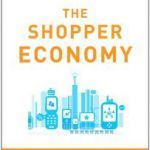
You’re a marketer. You spend countless hours measuring, analyzing and strategically planning ways to “build a better mousetrap.” If you think you know what’s going on inside your customers’ head, Liz Crawford will challenge you to think again. Liz Crawford, author and analyst, has over twenty years’ experience in brand management and consulting with a concentration in strategic innovation. We recently co-hosted a webinar with Liz, examining key concepts from her book The Shopper Economy: The New Way to Achieve Marketplace Success by Turning Behavior into Currency. In this webinar, Liz explains the changing consumer behavior and defines “value transactions” that illustrate your customers’ ever-growing role in their relationships with brands.
Marketing used to facilitate a customer transaction with a brand, generally one that occurred before a sale. At the time, marketers ‘rewarded’ customer relationships by delivering a good or service. Today, it’s no longer enough to simply reward your customers for buying your product. Consumers want a reward for their behavior as well.
In the webinar, Liz examines the transformed relationship of buyer and seller, likening it to one of employee / employer. By building marketing strategies with this framework in mind, we can create “value transactions” that effectively reward customers based on their behaviors. As an example, Liz points out that Motorola rewards customers with one minute of additional phone time for watching a one-minute advertisement. In this example, customers are rewarded for a particular behavior: their attention to an asset Motorola considers valuable, hence a “value transaction.” She cites multiple instances of companies seeking a certain behavior, such as customer attention, participation, advocacy, commitment, before reciprocating with an appropriate reward like PayPal cash, gift cards, exclusive access to content, earning a desired item, and discounts.
As Liz would advise, customers understand their elevated level of influence and control over brands, citing a Dunkin’ Donuts example to illustrate the premise. When Dunkin’ Donuts customers were promised a free K-Cup for “Liking” a Facebook page and did not receive one, they voiced their disappointment. They expected a reward for their action and took action to get noticed by commenting on the Dunkin’ Donuts Facebook page. This elicited a fast response from Dunkin’ Donuts to fix the problem.
I know what you are thinking – rewarding customers for actions other than buying your products can be really costly. As Liz shares, you don’t have to break the bank when rewarding your customers for more than their purchases – on the contrary, you can and will make more money if you approach the new Shopper Economy right. For an in-depth examination of how a number of socially savvy brands are effectively targeting behaviors and developing meaningful and measurable relationships with their customers – watch The Shopper Economy webinar recording here. You can also download chapter 1 of The Shopper Economy here.We guarantee you’ll learn some great new ideas and ways to identify key behaviors to effectively elevate your sales strategy to encompass these insights. Don’t forget to tell us your key takeaways on Twitter at #AwarenessTips.
[image error]
May 15, 2012
Will Facebook One Day Go the Way of Beanie Babies and New Coke?

[image error]We all know over time that things come and go. That being said, could you imagine a world one day without Facebook?
When you add up the numbers, approximately 900 million people worldwide utilize Facebook, with the company’s Q1 revenue for 2012 alone more than $1 billion.
Impressive numbers to say the least, but of course the world had been around for centuries and centuries before Mark Zuckerberg and the social media giant became a part of our everyday fabric less than a decade ago. With that being the case, don’t just assume that we’ll be sharing things on Facebook with friends, family and co-workers for many decades to come.
Number of Challenges for Facebook
According to a recent Associated Press-CNBC poll, Americans are proving a tad ambivalent about Facebook, showing that the company is looking at a number of challenges as it looks to bring in additional revenue growth via its huge user base.
The poll sample of just more than 1,000 American adults (56 percent had a Facebook profile, 40 percent did not, while 4 percent did not know), shows that 71 percent of individuals under age 35 sport a favorable view of the site compared to 28 percent of senior citizens. The poll points out that Google, Apple and Microsoft are seen as better sites than is Facebook, while Twitter received less favorable reviews.
Among individuals reporting they did not use Facebook (it was not clear whether this also includes individuals with profiles), a total of 57 percent indicated they either lacked interest or actively did not like the company.
When it comes to e-commerce on Facebook, 36 percent report they thought they were “extremely” or “somewhat safe” buying goods through the site. Meantime, 54 percent indicated they felt “not at all safe.” As for ad-related or sponsored clicks, 83 percent reported they “hardly ever or never” clicked on Facebook ads or sponsored content, with 17 percent claiming they did “often or sometimes.”
What may be the most interesting finding from the survey is the thought of Facebook, which makes the bulk of its money from selling advertisements, as an investment, along with its longevity and revenue futures.
According to nearly half of those responding, Facebook “will fade away as new things come along.” Even more interesting, was the fact that “Although they are generally more positive about the company, younger adults are no more apt than their older counterparts to expect Facebook’s long-term success.”
The poll also looked at the trust issue between users and the company, another feature that did not paint the social media leader in an exactly positive light. A mere 13 percent “completely trust” Facebook, as three of five Facebook users indicate they have little or no faith the site will protect their personal data, while 28 percent “somewhat trust” it.
The survey comes on the heels of the company’s initial public offering (IPO) of stock, with half of Americans claiming Facebook’s proposed asking price is too large.
So, take a moment to think about Facebook from your perspective:
Do you regularly, somewhat or never use Facebook?
If Facebook went away tomorrow, would you be upset, happy or indifferent?
Do you feel Facebook is overrated or underrated as a major social media player?
Photo credit: thenextweb.com
[image error]
Chatting up Influence with Dave Balter, CEO of BzzAgent

Dave Balter is a man who needs no introduction. As CEO of BzzAgent, a company that connects brands with over 400 million global brand advocates and author of two word-of-mouth marketing books, there’s hardly a person better suited to speak on influence and word-of-mouth (WOM). We recently caught up with Dave to interview him for our latest e-book, 3 Keys to Influence: Understanding and Leveraging Social Capital, and talk about influence and how marketers can leverage it.
Dave defines influence as the “ability to motivate others to take an action.” He notes influence also incorporates elements of reach and amplification – as those with influence know key people and can communicate effectively with them to drive action. According to Dave, the way to most successfully harness influence is to create advocates out of those with influence, as WOM marketing is made even more powerful when it begins with an influential voice.
In order to leverage influence, marketers must provide their brand advocates with the tools and insights needed to influence others. Brand advocates, Dave feels strongly, must be brand users. A brand advocate must have first-hand experience to effectively communicate and influence others. We differ a bit here, as I believe advocates can come from outside of one’s customer base. However, we agree that no matter how you identify and motivate influencers, you must do it in a transparent and honest manner. Marketers must be upfront with those they are engaging.
We live in an era where peer-to-peer marketing is a critical component of our campaigns, but challenging to pull through. To that end, Dave shares two key tips for influencer engagement strategy.
1) Be upfront with your ask. A critical component of getting someone to take an action is to invite them in a transparent way. Reach out to your target influencers and invite them to be a part of your campaign (e.g. your innovative new strategy, or cool product launch). They can’t advocate for you without being asked. Plus, Dave adds, people love feeling specially selected.
2) Appropriately equip advocates with actions that will create activation. Once you’ve asked your influencers to participate, you need to tell them how to help. Clearly identify the right tool to motivate your audience to take an action, whether that’s a tangible item, like coupons to distribute, or knowledge that’s worth sharing and communicating.
Dave believes measuring influence and measuring return on advocacy campaigns are different. If you are identifying influencers, there are tools like Klout, PeerIndex and Traackr. To measure return on WOM and advocacy, marketers need measure it the same ways they measure traditional marketing campaigns. For BzzAgent, the leading company that utilizes a global network of advocates to create value for brands, that means tying campaign performance directly to purchases.
Dave is confident that the industry is increasingly moving towards tying social with purchasing behavior. We are moving away from ‘squishy’ metrics to ones that are measurable and defensible, complementary to metrics marketers use in traditional campaign measurement. You can expect to see more marketers measuring sales during the time an advocacy campaign is running.
Those looking to grow their own influence, Dave advises, need to focus on growing their reach, or the number of people with whom you’re able to communicate, and their credibility with those people, generally achieved through creating and sharing high-quality content. For more on growing and leveraging insights, as well as even more tips from Dave, download our latest e-book 3 Keys to Influence: Understanding and Leveraging Social Capital.
Marketers, do you agree brand advocates can only be customers? What are your best practices for growing and nurturing your brand’s influence? Share your tips and thoughts with us and our community on Twitter by tweeting to #AwarenessTips.
Mike Lewis
[image error]
May 14, 2012
Social Mobile and Desktop Applications for the Digital Marketer

As social media sites continue to emerge as the basis of connectivity among marketers, so does the demand for fresh content. However, do you ever feel like it takes too much time to jump from site-to-site in order to update? Luckily, software developers are already one step ahead with their brilliant mobile and desktop applications.
Until recently, I’ve never been Pinterested, Get Gluey, Google Plusified, Spotified, Tumbly or Youtubed… On the other hand, I can say I’ve been an active Facebooker, Tweeter, Instagramer, and FourSquare-er. But really, who has time to go through and update all of their social networks while navigating through this busy and crazy life we all live?
Well, as social media sites continue to aggregate my biggest recommendation for staying abreast with your updates is to select a few desktop or mobile applications that serve as your “Go-Tos,” where you can easily update all sites with one update.
Desktop Apps
For me, I really enjoy Facebook and Twitter. So, if I’m going to be doing a lot of work pushing out content for those two platforms, I utilize Tweetdeck from my desktop. You can download the mobile version as well, but the desktop version helps me to respond to people quicker and in real time. If I’m going to be analyzing this data, I utilize the desktop application, Social Bro. It provides simple up-to-date reports on who I’m connecting with, who is in their network, and where they are. There’s also more analytical data you can choose from based on your preferences.
Mobile Apps
As far as social mobile applications, Echofon, Hootsuite, and Tweetcaster and among my top three. Echofon and Tweetcaster are good because they allow you to easily, “Retweet with Comment” when replying to someone. Twitterlingo can be confusing. Therefore if you have the capability of showing your recipient what exact tweet you’re referring to by including it in YOUR tweet, then your conversations will run much smoother. Hootsuite is awesome because you can post to Facebook, Twitter, Foursquare, and Linked In simultaneously, eliminating the need for jumping from site-to-site-to-site.
[image error][image error][image error]
Stay Connected
Finally, I believe that as more of these types of applications continue to emerge it is important to connect all networks in the settings utility. Therefore, you only have to do one update for multiple networks. This is beneficial because if you’re promoting a product and someone sees it on Instagram, Facebook, Pinterest, and Twitter, they are more likely to check it out versus only one social site.
In a digital world driven by social outlets, marketers must utilize their ability to expand their reach for potential B2B and B2C clients.
[image error]

